Free Courses Sale ends Soon, Get It Now


Free Courses Sale ends Soon, Get It Now



Disclaimer: Copyright infringement not intended.
Context: The Kerala government recently announced the State’s first waste-to-energy project in Kozhikode.
Details:
What do these plants do?
Need:
Reasons for failure:
How can these issues be resolved?
MUST READ: https://www.iasgyan.in/blogs/waste-to-energy
|
PRACTICE QUESTION Q) Discuss the significance of waste-to-energy plants from an economic as well as ecological perspective. (150 words) |
https://epaper.thehindu.com/ccidist-ws/th/th_delhi/issues/29552/OPS/GVEB13480.1+GIOB13H05.1.html
© 2024 iasgyan. All right reserved